

 中文摘要:
中文摘要:
运用RAPD技术对传统药用植物紫花地丁(Viola yedoensis)及其7个近缘种进行了分析,筛选出的6个随机引物在8个种39份材料中共扩增出163个位点,其中161个位点具有多态性,占98.7%;在扩增产物中有7条特异性扩增条带可用于紫花地丁的鉴定。根据RAPD结果计算的各种间遗传距离的范围为0.022 7-0.424 4,斑叶堇菜与细距堇菜的亲缘关系最近,它们间的遗传距离最小(0.022 7),而与紫花地丁遗传距离最近的是早开堇菜,为0.147 1。在所研究的类群中,维西堇菜与裂叶堇菜的遗传距离最大(0.424 4)。根据遗传距离所作的聚类分析结果与紫花地丁等8种植物的形态分化相一致,此外,同一种的不同个体总是先聚在一起,反映了种内不同个体在遗传组成上相对一致性。研究结果表明,RAPD在种内是相对稳定的,能快速、准确地应用于紫花地丁的分子鉴定及其与近缘类群关系的研究。
 英文摘要:
英文摘要:
In the present paper,the genetic relationship between Chinese traditional medicinal plant Viola yedoensis with its related species,such as V.prionantha,were analyzed by random amplified polymorphic DNA(RAPD).The six random primers selected were amplified 163 loci,of which 161 loci presented polymorphism,accounting for 98.7%.V.yedoensis could be distinguished from others with 7 specific bands.RAPD analysis indicated the genetic distances among all the species were 0.022 7-0.424 4.V.variegata and V.tenuicornis showed greater similarity and the genetic distance between them was only 0.022 7,and V.yedoensis had the nearest genetic distance to V.prionantha(0.147 1),V.monbeigii and V.dissecta were 0.424 4 apart,were the longest genetic distance in all the species studied here.Clustering analysis based on genetic distances gave similar results to morphological difference among these species.The individuals of the same species showed more genetic similarity and they got together in the cluster tree.The above results indicated that RAPD was a suitable technique for identification and relative analysis of V.yedoensis and its related species.
 同期刊论文项目
同期刊论文项目
 同项目期刊论文
同项目期刊论文
 期刊信息
期刊信息
